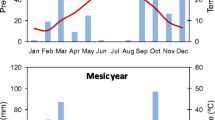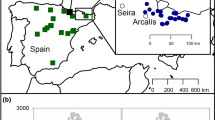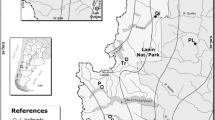Abstract
Increased drought severity is expected in the Mediterranean Basin over the twenty-first century, but our understanding of the potential of most forest tree species to cope with it remains uncertain. In this study, (1) we examined the potential effects of long-term selection and the capacity to respond to future changes in selective pressures in three populations of cork oak (Quercus suber L.). For this purpose, we evaluated the response to dry conditions of 45 open-pollinated trees originating from populations in Morocco, Portugal, and Spain. Growth, leaf size, specific leaf area (SLA), carbon isotope discrimination (Δ13C), leaf nitrogen content (Nmass), and total chlorophyll content (Chlmass) were measured in 9-year-old plants. (2) We also investigated the relationships between functional traits and aboveground growth by regression models. Plants presenting larger and more sclerophyllous leaves (low SLA and high leaf thickness) exhibited higher growths, with results suggesting that these traits are subjected to divergent selection in this species. Heritability estimates were moderately high for Δ13C (0.43 ± 0.25–0.83 ± 0.31) and stem diameter (0.40 ± 0.15–0.71 ± 0.28) for the tree populations. For the rest of the traits (except for annual growth), heritability values varied among populations, particularly for height, leaf size, leaf thickness, and Nmass. Our results suggest that natural selection has led to local adaptations and has also affected the genetic variance intrapopulation in these cork oak populations, although studies with a higher number of populations should be carried out across different years. Additionally, the absence of significant genetic correlations and the fact that correlated traits did not undergo opposing selection provided little evidence for constraints on evolution caused by genetic correlations.

Similar content being viewed by others
References
Ackerly D (2004) Functional strategies of chaparral shrubs in relation to seasonal water deficit and disturbance. Ecol Monogr 74:25–44
AOAC (Association of Official Analytical Chemist) (1990) Official methods of analysis, 15th edn. Association of Official Analytical Chemist, Washington, DC
Aranda I, Castro L, Pardos M, Gil L, Pardos JA (2005) Effects of the interaction between drought and shade on water relations, gas exchange and morphological traits in cork oak (Quercus suber L.) seedlings. For Ecol Manag 210:117–129
Aranda I, Pardos M, Puértolas J, Jiménez MD, Pardos JA (2007) Water use efficiency in cork oak (Quercus suber L.) is modified by the interaction of water and light availabilities. Tree Physiol 27:671–677
Arnold SJ (1992) Constraints on phenotypic evolution. Am Nat 140:85–107
Aronson J, Pereira JS, Pausas JG (2009) Cork oak woodlands on edge: ecology, adaptive management and restoration. Island, Washington, DC
Benjamini Y, Hochberg Y (1995) Controlling the false discovery rate: a practical and powerful approach to multiple testing. J R Stat Soc 57:289–300
Burgarella C, Lorenzo Z, Jabbour-Zahab R, Lumaret R, Guichoux E, Petit RJ, Soto A, Gil L (2009) Detection of hybrids in nature: application to oaks (Quercus suber and Q. ilex). Heredity 102:442–452
Campbell DR (1997) Genetic and environmental variation in life-history traits of a monocarpic perennial: a decade-long field experiment. Evolution 51:373–382
Casper BB, Forseth IN, Wait DA (2005) Variation in carbon isotope discrimination in relation to plant performance in a natural population of Cryptantha flava. Oecologia 145:541–548
Cheverud JM (1984) Quantitative genetics and developmental constraints on evolution by selection. J Theor Biol 110:155–171
Cornelissen JHC, Castro-Díez P, Carnelli AL (1998) In: Lambers H, Poorter H, Van Vuuren MMI (eds) Variation in relative growth rate among woody species. Inherent variation in plant growth. Physiological mechanisms and ecological consequences. Backhuys, Leiden, p 363
Cotter SL, Kruuk LEB, Wilson K (2004) Costs of resistance: genetic correlations and potential trade-offs in an insect immune system. J Evol Biol 17:421–429
David TS, Henriques MO, Kurz-Besson C, Nunes J, Valente F, Vaz M, Pereira JS, Siegwolf R, Chaves MM, Gazarini LC, David JS (2007) Water-use strategies in two co-occurring Mediterranean evergreen oaks: surviving the summer drought. Tree Physiol 27:793–803
Donovan LA, Dudley SA, Rosenthal DM, Ludwig F (2007) Phenotypic selection on leaf water use efficiency and related ecophysiological traits for natural populations of desert sunflowers. Oecologia 152:13–25
Dudley SA (1996) Differing selection on plant physiological traits in response to environmental water availability: a test of adaptive hypotheses. Evolution 50:92–102
Falconer DS, Mackay TFC (1996) Introduction to quantitative genetics. Longmans Green, Harlow
Farqhuar GD, O’Leary MH, Berry JA (1982) On the relationship between carbon isotope discrimination and the intercellular carbon dioxide concentration in leaves. Aust J Plant Physiol 9:121–137
Farquhar GD, Ehleringer JR, Hubick KT (1989) Carbon isotope discrimination and photosynthesis. Ann Rev Plant Physiol Plant Mol Biol 40:503–537
Fotelli MN, Radoglou KM, Constantinidou HIA (2000) Water stress responses of seedlings of four Mediterranean oak species. Tree Physiol 20:1065–1075
Gandour M, Khouja ML, Toumi L, Triki S (2007) Morphological evaluation of cork oak (Quercus suber L.): Mediterranean provenance variability in Tunisia. Ann For Sci 64:549–555
García LV (2004) Escaping the Bonferroni iron claw in ecological studies. Oikos 105:657–663
Gates DM (1980) Biophysical ecology. Springer, New York
Geber MA, Dawson TE (1993) In: Kareiva PM, Kingsolver JG, Huey RB (eds) Evolutionary responses of plants to global change. Biotic interactions and global change. Sinauer, Sunderland
Geber MA, Griffen LR (2003) Inheritance and natural selection on functional traits. Int J Plant Sci 164:21–42
Giles BE, Pettersson TM, Carlsson-Graner U, Ingvarsson PK (2006) Natural selection on floral traits of female Silene dioica by a sexually transmitted disease. New Phytol 169:729–739
Givnish TJ (1979) In: Solbrig OT, Jain S, Johnson GB, Raven PH (eds) On the adaptive significance of leaf form. Topics in plant population biology. Columbia University Press, New York, pp 375–407
Gratani L, Varone L (2006) Long-time variation in leaf mass and area of Mediterranean evergreen broad-leaf and narrow-leaf maquis species. Photosynthetica 44:161–168
Gratani L, Meneghini M, Pesoli P, Crescente MF (2003) Structural and functional plasticity of Quercus ilex seedlings of different provenances in Italy. Trees Struct Funct 17:515–521
Grossmann A, Romane F, Grandjanny M (2002) The climate environment of the ‘CASCADE’ sites. II Report CNRS-CEFE for the EU Project EVK2-CT-1999-00006
Guyette RP, Muzika R, Kabrick J, Stambaugh MC (2004) A perspective on Quercus life history characteristics and forest disturbance. In: Spetich M (ed) Proceedings of the upland oak ecology symposium. Gen. Tech. Rep. SRS-73. US Department of Agriculture, Forest Service, Southern Research Station, Asheville, 311 pp
Hamrick JL (2004) Response of forest trees to global environmental changes. For Ecol Manag 197:323–335
Heschel MS, Donohue K, Hausmann NJ, Schmitt J (2002) Population differentiation and natural selection for water-use efficiency in Impatiens capensis (Balsaminaceae). Int J Plant Sci 163:907–912
Heschel MS, Sultan S, Glover S, Sloan D (2004) Population differentiation and plastic responses to drought stress in the generalist annual, Polygonum persicaria. Int J Plant Sci 165:817–824
Hijmans RJ, Cameron SE, Parra JL, Jones PG, Jarvis A (2005) Very high resolution interpolated climate surfaces for global land areas. Int J Climatol 25:1965–1978
Hodgins KA, Barrett SCH (2008) Natural selection on floral traits through male and female function in wild populations of the heterostylous daffodil Narcissus triandrus. Evolution 62:1751–1763
Horn HS (1971) The adaptive geometry of trees. Princeton University Press, Princeton
IPCC (2007) Climate change 2007: the physical basis. Contribution of Working Group I to the Fourth Assessment of the Intergovernmental Panel on Climate Change. IPCC Secretariat, Geneva
Jiménez-Anca D (2000) Variaciones entre procedencias de Quercus suber L. Proyecto fin de carrera. Universidad Politécnica de Madrid, Madrid
Jiménez P, Agúndez D, Alía R, Gil L (1999) Genetic variation in central and marginal populations of Quercus suber L. Silvae Genet 48:278–284
Johnsen KH, Flanagan LB, Huber DA, Major JE (1999) Genetic variation in growth, carbon isotope discrimination, and foliar N concentration in Picea mariana: analyses from a half-diallel mating design using field-grown trees. Can J For Res 29:1727–1735
Kaczorowski R, Juenger TE, Holtsford TP (2008) Heritability and correlation structure of nectar and floral morphology traits in Nicotiana alata. Evolution 62:1738–1750
Lande R, Arnold SJ (1983) The measurement of selection on correlated characters. Evolution 37:1210–1226
Lauteri M, Pliura A, Monteverdi MC, Brugnoli E, Villani F, Eriksson G (2004) Genetic variation in carbon isotope discrimination in six European populations of Castanea sativa Mill. originating from contrasting localities. J Evol Biol 17:1286–1296
Leiss KA, Vrieling K, Klinkhamer PGL (2004) Heritability of nectar production in Echium vulgare. Heredity 92:446–451
Leiva MJ, Fernández-Alés R (1998) Variability in seedling water status during drought within a Quercus ilex subsp. ballota population, and its relation to seedling morphology. For Ecol Manag 111:147–156
Lloret F, Peñuelas J, Ogaya R (2004) Establishment of co-existing Mediterranean tree species under a varying soil moisture regime. J Veg Sci 15:237–244
Ludwig F, Rosenthal LF, Johnston JA, Kane N, Gross BL, Lexer C, Dudley SA, Riesenberg LH, Donovan LA (2004) Selection on leaf ecophysiological traits in a desert hybrid Helianthus species and early-generation hybrids. Evolution 58:2682–2692
Lynch M, Walsh B (1998) Genetics and the analysis of quantitative traits. Sinauer, Sunderland
Marchin RM, Sage EL, Ward JK (2008) Population-level variation of Fraxinus americana (white ash) is influenced by precipitation differences across the native range. Tree Physiol 28:151–159
Matzner SL, Rice KJ, Richards JH (2001) Factors affecting the relationship between carbon isotope discrimination and transpiration efficiency in blue oak (Quercus douglasii). Aust J Plant Physiol 28:49–56
Mediavilla S, Escudero A (2003) Photosynthetic capacity, integrated over the lifetime of a leaf, is predicted to be independent of leaf longevity in some tree species. New Phytol 159:203–211
Niinemets Ü, Portsmuth A, Tena D, Tobias M, Matesanz S, Valladares F (2007) Do we underestimate the importance of leaf size in plant economics? Disproportionate scaling of support costs within the spectrum of leaf physiognomy. Ann Bot 100:283–303
Nobel PS (1999) Physiochemical and environmental plant physiology. Academic, New York
Parmesan C (2006) Ecological and evolutionary responses to recent climate change. Ann Rev Ecol Evol Syst 37:637–669
Peguero-Pina JJ, Sancho-Knapik D, Flexas J, Gil-Pelegrín E (2009) Differential photosynthetic performance and photoprotection mechanisms of three Mediterranean evergreen oaks under severe drought stress. Funct Plant Biol 36:453–462
Petit RJ, Hampe A (2006) Some evolutionary consequences of being a tree. Ann Rev Ecol Evol Syst 37:187–214
Prasolova NV, Xu ZH, Farquhar GD, Saffigna PG, Dieters J (2001) Canopy carbon and oxygen isotope composition of 9-year-old hoop pine families in relation to seedling carbon isotope composition and growth, field growth performance and canopy nitrogen concentration. Can J For Res 31:673–681
Quero JL, Villar R, Marañón T, Zamora R, Poorter L (2007) Seed mass effect in four Mediterranean Quercus species (Fagaceae) growing in contrasting light environments. Am J Bot 94:1795–1803
Quero JL, Villar R, Marañón T, Zamora R, Vega D, Sack L (2008) Relating leaf photosynthetic rate to whole-plant growth: drought and shade effects on seedlings of four Quercus species. Funct Plant Biol 35:725–737
Ramírez-Valiente JA, Valladares F, Gil L, Aranda I (2009a) Population differences in juvenile survival under increasing drought are mediated by seed size in cork oak (Quercus suber L.). For Ecol Manag 257:1676–1683
Ramírez-Valiente JA, Lorenzo Z, Soto A, Valladares F, Gil L, Aranda I (2009b) Elucidating the role of genetic drift and natural selection in cork oak differentiation regarding drought tolerance. Mol Ecol 18:3803–3815
Ramírez-Valiente JA, Sánchez-Gómez D, Valladares F, Aranda I (2010a) Phenotypic plasticity and local adaptation in leaf ecophysiological traits of thirteen contrasting cork oak populations under different water availabilities. Tree Physiol. doi:10.1093/treephys/tpq013
Ramírez-Valiente JA, Lorenzo Z, Soto A, Valladares F, Gil L, Aranda I (2010b) Natural selection on cork oak: allele frequency reveals divergent selection in cork oak populations along a temperature cline. Evol Ecol. doi:10.1007/s10682-010-9365-6
Reich PB, Waters MB, Ellsworth DS (1997) From tropics to tundra: global convergence in plant functioning. Proc Natl Acad Sci U S A 94:13730–13734
Reich PB, Tjoelker MG, Walters MB, Vanderklein DW, Bushena C (1998) Close association of RGR, leaf and root morphology, seed mass and shade tolerance in seedlings of nine boreal tree species grown in high and low light. Funct Ecol 12:327–338
Roff DA (1997) Evolutionary quantitative genetics. Chapman and Hall, New York
Shaw RG, Byers DL (1998) Genetics of maternal and paternal effects. In: Mousseau T, Fox C (eds) Maternal effects as adaptations. Oxford University Press, New York, pp 97–111
Shipley B (2006) Net assimilation rate, specific leaf area and leaf mass ratio: which is most closely correlated with relative growth rate? A meta-analysis. Funct Ecol 20:565–574
Soto A, Lorenzo Z, Gil L (2007) Differences in fine-scale genetic structure and dispersal in Quercus ilex L. and Q. suber L.: consequences for regeneration of mediterranean open woods. Heredity 99:601–607
Stinchcombe JR, Agrawal AF, Hohenlohe PA, Arnold SJ (2008) Estimating nonlinear selection gradients using quadratic regression coefficients: double or nothing? Evolution 62:2435–2440
Thornthwaite CW (1948) An approach toward a rational classification of climate. Geogr Rev 38:55–94
Toumi L, Lumaret R (1998) Allozyme variation in cork oak (Quercus suber L.): the role of phylogeography and genetic introgression by other Mediterranean oak species and human activities. Theor Appl Genet 97:647–656
Ward JK, Kelly J (2004) Scaling up evolutionary responses to elevated CO2: lessons from Arabidopsis. Ecol Lett 7:427–440
Ward JK, Antonovics J, Thomas RB, Strain BR (2000) Is atmospheric CO2 a selective agent on model C3 annuals? Oecologia 123:330–341
Wellburn AR (1994) The spectral determination of chlorophyll a and b, as well as total carotenoids, using various solvents with spectrophotometers of different resolution. J Plant Physiol 144:307–313
Xu ZH, Prasolova N, Lundkvist K, Beadle C, Leaman T (2003) Genetic variation in branchlet carbon and nitrogen isotope composition and nutrient concentration of 11 year-old hoop pine families in relation to tree growth in subtropical Australia. For Ecol Manag 186:359–371
Yoder B (1992) Photosynthesis of conifers: influential factors and potential for remote sensing. Dissertation. Oregon State University, Corvallis
Acknowledgements
We are grateful to Pedro Fernández, Laura Castro, Regina Chambel, José María Climent, Pilar Jiménez, and everyone from the Forestry School of Madrid who collaborated in the setting up of the cork oak common gardens under the EU-concerted action on cork oak, FAIR I CT 95 0202. We would also like to thank Salustiano Iglesias and the DGB for the maintenance of the assays, and Ricardo Alía for a previous review of the draft and his helpful comments. We thank Matthew Robson who made a thorough review of the English version and contributed with valuable suggestions. This work was funded by the Spanish Ministry of Science (PLASTOFOR, AGL-00536/FOR and BOSALIM, and CGL2007-66066-C04-02 and CGL2007-66066-C04-03 projects). This study was also supported by a MEC-FPI fellowship (BES-2005-7573) to JARV.
Author information
Authors and Affiliations
Corresponding author
Additional information
Communicated by S. González-Martínez
Electronic supplementary material
Below is the link to the electronic supplementary material.
Figure S1
Relationship between carbon isotope composition (δ13C) obtained from a subsample ground with pottery mortar and the δ13C obtained from another subsample of the same leaves ground in a mill using staining steel balls (prior to the inclusion of the material in plastic Eppendorfs) (DOC 78 kb)
Figure S2
Average values of annual growth, isotopic discrimination, specific leaf area, and average leaf size for 45 open-pollinated families (15 per population) measured in three cork oak populations in a common garden experiment. Bars represent average values ± SE (n = 8)
Table S1
Genetic correlations between ecophysiological traits for each population
Rights and permissions
About this article
Cite this article
Ramírez-Valiente, J.A., Valladares, F., Delgado Huertas, A. et al. Factors affecting cork oak growth under dry conditions: local adaptation and contrasting additive genetic variance within populations. Tree Genetics & Genomes 7, 285–295 (2011). https://doi.org/10.1007/s11295-010-0331-9
Received:
Revised:
Accepted:
Published:
Issue Date:
DOI: https://doi.org/10.1007/s11295-010-0331-9




